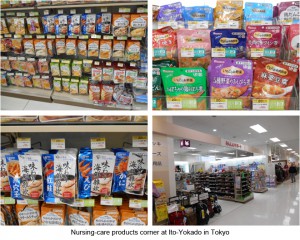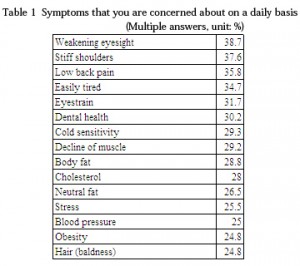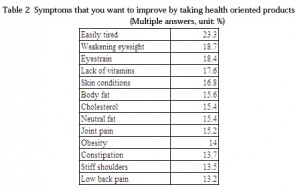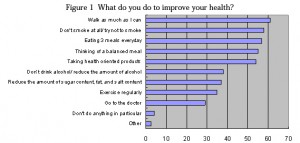Food market for nursing care exceeding 100 billion yen. Potential needs are 2.5 trillion yen
The nursing care food market including elderly food is rapidly expanding. According to a research conducted by Fuji Keizai, the nursing care food market was up 5% from the previous year, reaching a 102 billion yen market in 2012. Nursing care food includes liquid food, soft food, nutritional supplementary food, hydration supplementary food, and thickness adjusting foods. The market is estimated to continue expanding as the elderly population rises. By 2020, it is said to grow 26% from 2012 to a 128.6 billion yen market.
Elderly population of over 65 years old continued to grow each year and currently passed 30 million. Commercial products of soft foods will help seize a business opportunity for elderly who feel that “hard and big foods are difficult to eat.” With new entries and expansion of products, each maker is beginning to notice the market is become actualized.
In the future, home use products will capture attention as the market grows. The needs of the nursing care foods calculated from the number of people requiring nursing care is about 2.5 trillion yen. This is calculated by “1380 yen for daily food expenses in nursing care insurance system” x 365 days x 5.06 million people requiring nursing care. Currently, the number of elderly receiving nursing care at home out of those who require nursing care are about 4.22 million. Of this number, about 1.2 million are conducted by family members and this number clearly indicates the potential needs for home use nursing care food.
Obviously, it does not mean that every elderly who are receiving care at home need nursing care food, but it is trouble and time consuming to prepare minced or paste food. Out of the total number of households, 30% are over 65 years old and there are many elders who look after another elder. A system that would promote the benefits and advantages of commercial nursing care foods to not only elders who does nursing care, but also to home helpers would become a key to further market expansion.
There are several barriers to market expansion of home use nursing care foods. There are many elderly who does not know about nursing care food, and it is necessary to first take business measures to increase the degree of recognition. It is also important to expand the distribution routes. Currently, the main distribution routes are drug stores and mail orders. There are limits to the number of GMs and SMs that handle these products in their food sales counter. The biggest task for market expansion is to secure a place to sell the products.
According to Ito-Yokado, “We have currently about 150 nursing care food items. The selling area is expanding each year. The percentage of nursing care food out of the total amount of sales is increasing. In the future, we want to consider selling frozen nursing care foods that are highly evaluated for its taste by setting refrigeration showcases.” Their idea is to have a fulfilling number of items.
The Ministry of Agriculture, Forestry and Fisheries invited experts and intellectuals to start a debate on elderly foods, a topic that has never been discussed comprehensively.
1) Clarifying the definition of nursing care foods, 2) promoting the understanding regarding nutrition for elderly, 3) ways to provide nursing care foods, 4) spreading nursing care foods, 5) developing a social system to utilize nursing care foods.
Since the government has officially begun to work on nursing care foods, there are hopes for the market to pick up speed.
Trends of Health Oriented Food Market in Japan
There is a remarkable growth in population of those over the age of 65, and products from the health oriented food market targeting middle age and elderly people are quite active (estimated elderly rate of 2030: Tokyo 28.0%, UK 20.9%, US 19.8%, China 15.9%). It is pointed out that the life style of Japanese people changed since 3.11 East Japan Great Earthquake, especially towards the idea of “looking after your own health conditions.” While people are trying to save up and stop spending on unnecessary things, investment towards health seems to be expanding along with the aged population.
Here is the recent result of an online survey held annually by a consumer research group of Health and Food Forum. The survey was taken by about 350 male and 350 female (total of 726 people) of age 20-70 who have heath orientated food over once a week. The graphs show the results of questions regarding health problems and health oriented products. Table 1 is the result for “symptoms that you are concerned about on a daily basis” and Table 2 shows “symptoms that you want to improve by taking health oriented products.” Both Tables 1 and 2 show answers of male and female with multiple answers. Representative symptoms regarding health are “weakening eyesight,” “body fat,” and “blood pressure” for males, “stiff shoulders,” “cold sensitivity,” and “constipation” for females.
The answers to the question “What do you do to improve your health?” are shown in Figure 1.
The top 3 answers were “walk as much as I can,” “don’t smoke at all, try not to smoke,” and “eating 3 meals every day.” In 4th came “taking health oriented products” with 54 %. When asked about specific names of the health oriented products taken regularly (over once a week), there were a total of 526 products in the order of glucosamine, chondroitin, multi-vitamins, blueberries, black vinegar/kouzu (fermented rice vinegar), garlic, and vitamin C. Supplements ranked higher than foods since the functions are more obvious. These products are mostly purchased online (42%), and this is followed by drug stores (27%), mail order (catalogue, magazine, newspaper) (11%), and supermarkets remained low at 5% possibly due to lack of variety. Even within mail order, TV and radio accounts for only 1%. The possible answer for this is because there are continued users.
Most people get their information about health oriented products through the Internet/ PC (47%). Store counters, TV and from family & friends each were from 20-30%. Information from specialists such as doctors or pharmacist remained low at 5%. Information gained from the Internet is “the effects” (60%), “functional ingredients” (15%), and “safety” (10%).
Locomotive related products have a steady market of nearly 50 billion yen with demands for products including glucosamine and chondrotin to ease joint pain for middle age and elderly people. Products related to beautiful skin are also popular among middle age and elderly women, and there is a 100 billion yen market for supplements where the main components are vitamin C, collagen, or hyaluronic acid.
The main pillars are collagen and hyaluronic acid, which are both strong at drugstores and mail order market. Also, placenta is a popular product. Although the market is quite small at 5 billion yen, it is estimated to grow in the future because of its effects for beautiful skin and effects to easing tiredness. For products related to easing tiredness, royal jelly and garlic are traditional nutritional fortification with firm grounds. With its history and background of Chinese herbal medicine, it captures the attention of consumers. This field has an estimate of nearly 100 billion yen market, and there are possibilities of further expansion due to the aging society.
On the other hand, dieting supplements that target young women include protein, garcinia cambogia, and gymnemic acid. Products that control the calories after eating a meal and products that burn fat are attracting interest.
Formalization of reforms on indicating health functions
Currently, the Japan Heath and Nutrition Food Association, commissioned by the Consumer Affairs Agency, are operating a “model project on evaluating the functions of foods.” They are doing a research on whether to approve functional marking of new components. This model project is researching on 11 components. Selenium, n-3 fatty acid, lutein, coenzyme q10, hyaluronic acid, blueberry extract, glucosamine, BCAA, ginkgo extract, saw palmetto, and lactoferrin. The industry hopes that functional markings for these effective components will be approved, and activate the industry as a whole. After the Great East Japan Earthquake on March 11 this year, many people had unbalanced meals, mainly eating carbohydrates such as rice balls and bread. This caused functional foods and dietary supplements to attract attention. There were many types of functional foods and dietary supplements in the aid stuff that helped prevent transmitted diseases and decrease of physical strength. On the other hand, products with little familiarity about its functions are not popular among consumers since they do not know its functions very well. It is important to let more people know about these products and inform them of its functions. In the aging society, we must promote preventive medication to reduce the amount of medical fees. In this sense, approving the markings of functional foods and its effects is deemed to be necessary.
Trend of major companies within Japan Yakult Honsha Co.
A dairy, lactic fermenting beverage, “Pletio” (100ml paper container) is a specified health use food for people with high blood pressure. Next year, they will reform the flavor into yogurt in order to make it easier to drink. They will also remake the package to have a better idea for its functions and taste than before. “Pletio” contains 10g of “GABA” in one bottle, which is a mixed culture of bacterium lactobacillus casei Shirota and lactococcus lactis that is processed specially by Yakult Honsha. It controls the secretion of adrenaline, the cause of vasoconstriction, and lowers the blood pressure. According to the national health and nutrition examination survey conducted by the Health, Labour and Welfare Ministry, it is estimated that 40% of the people have hypertension in a population of 40 million (over 20 years old). Also, even if the number is in the normal range, there are over 15 million people who “have worries of getting hypertension” with a little high blood pressure.
Kaneka
Kaneka is putting their strength in selling “Reduced Form Coenzyme Q10.” In addition to that, they are also selling other dietary supplements online. It has been proven by joint researches by universities that this product has the effects to “improve the oral environment and prevent periodontal diseases” and “wrinkles formed by ultraviolet rays (photoaging).”
While oxidized forms must be converted into reduced forms when it enters the body, reduced forms are already reduced. This product has high hopes to contribute to the preserving of health for elders and people under stress with low capacity to reduce within their body.
Tsuji Oil Mills Co.
They are manufacturing products that are created by high extraction, purification, and fermentation technology, searching for the possibilities that natural products have. Some of their products are high-functioning lecithin, corn ceramide, fish collagen from fish scales. Their top seller is ceramide collagen beauty drink called “CeraFull,” and they have just renewed the package design in September. There is a similar product called “Ceramide Collagen Powder” (6g x 30 packs). This is a new product that started selling in November, and it is ginger flavored. It contains 1500ug of moisturizing ingredient ceramide from corn, 5000mg of collagen peptide, 2.5mg of elastin peptide, and some natural flavor of “ginger oil.” It could be carried around easily and melts in different kinds of foods like miso soup, soup, tea, and yogurt.
Lonza Japan
They sell “L-carnitine” which is a special type of amino acid that is absolutely necessary in burning body fat and changing it into energy. The company supplies 70% of “L-carnitine” in the Japanese market, and it is used in beverages, jelly, and many food products, as well as in dietary supplements. It is contained largely in red meat such as beef and lamb. Directly attaching to the fat in the body, it plays the role of carrying the fat to mitochondria, which is where the fat is burned. According to a new clinical data targeted for Japanese test subjects, it is recognized that it could help lower the level of neutral fat, which would lead to weight loss and weakening the risk of metabolism. “L-carnitine” is used in a product of a major food product company, and it is growing its sales.
Kewpie
Kewpie is the only company that has 2 ways of creating hyaluronic acid. One way is by extracting from the comb of a chicken and another is by fermentation. The first way is traditional, and it is used mainly at medical fields. High functional hyaluronic acid used for foods called “Hyabest(J)” is for supplements and ingestion. It is clear from clinical experiments that there is an effect for knee pain. They are providing their products to beverage and dietary supplement makers after they have these evidences. Although it is not for ingestion, “Hyaolo-Oligo” is used for face lotions since it absorbs well on to the skin with small amounts of hyaluronic acid. “Hialoveil” is used for hair shampoo, conditioner, and treatment since it sticks to the hair with an electrified hyaluronic acid. These high functional hyaluronic acids are not only selling their product in Japan, but also expanding their business mainly to East Asia, and to Europe and the US.
Riken Vitamin
Riken Vitamin’s healthcare department handles raw materials for medical products and additives for foods. Their most attractive functional raw material is crocetin. It is a natural raw material that is extracted and refined from cape jasmines. There has been evidence for that crocetin having recovery effects for eyestrain, but they have discovered a new skin perseverance effect as well. There are high hopes for this to be used in the beauty related field. Cape jasmine dye if known for its yellow natural color, and it is often used for mashed sweet potatoes with sweetened chestnuts, Chinese noodles, and saffron rice, but it has been reported by researchers that it also makes the blood flow smooth. With hopes that crocetin will have recovery effects of eyestrain, Riken Vitamin extracted and refined, high purity crocetin included in the color of cape jasmines. There was a clear recovery effect from fatigue by placebo. Riken Vitamin has already made a product called “crocetin eye” and they are selling this to health food makers.
Expansion of soybean functional foods and soymilk production continues
There is a growing interest in functionality of soybeans for many reasons including health, beauty and cooking, and the production of soymilk continues to expand. On the other hand, high functional ingredients based on soybean powder and soybean protein that aim to solve issues of users are also very active. Overall, the soybean functional foods market is getting greater attention than ever before.
In Korea, a country next to Japan, “Tofu Chips” sold at a donut chain store is popular. In Taiwan, China, in addition to “Grain Soymilk,” there are flavored soymilk such as strawberry, melon, and honey which is targeted for the beauty market. In China, demand for meat substitution products, snacks, and power bars using Soybean protein, which is a lot cheaper than meat protein is expected to grow. In Europe and Latin America, fruit based soybean beverages are increasing its sales due to its high evaluation in healthiness and abundant fiber. In Central America and Mexico, they are adding soybean powder to tortillas in order to increase the amount of protein. In Whole Foods Market in the US, there are shelves for processed soybean foods that sell tofu, processed tofu products, soymilk, veggie burger, and sausage. Functional foods and beverages using soybean and processed soybean products are the current global trend, and it will start spreading on a full scale in the Japanese market in the near future.
EDEN’s Vanilla Soymilk from the US is a popular imported soy product at organic stores and Rakuten (the biggest online shopping mall in Japan). Made from organic soybeans, it has been approved as overseas organic product. It does not contain any cholesterol or fat and it has high protein, beta-carotene, vitamin, and calcium. Many children and their parents enjoy the vanilla flavor.
Let’s take a look at national trends.
 Otsuka Pharmaceutical Co., Ltd. is developing and pursuing added values for soybean related products under the idea of “Soylution” which focuses on the health functions and nutritional value. Soylution is a coined word of Soy and Solution. A popular product from Otsuka, “Soyjoy”, currently has 12 different flavors including the new flavor “Fruity Tomato” that started selling this April. It is a new type of nutritional food, where it is made from powdered soybeans instead of flour, and contains a lot of fruits. Nutrition such as soybean protein and isoflavone from the soybean could be taken easily by eating the delicious bar. Also, from this March, the selling of “SOYSH”, a soybean carbonated beverage started in Japan. It has been developed as a beverage to take in nutrition from soybeans easily.
Otsuka Pharmaceutical Co., Ltd. is developing and pursuing added values for soybean related products under the idea of “Soylution” which focuses on the health functions and nutritional value. Soylution is a coined word of Soy and Solution. A popular product from Otsuka, “Soyjoy”, currently has 12 different flavors including the new flavor “Fruity Tomato” that started selling this April. It is a new type of nutritional food, where it is made from powdered soybeans instead of flour, and contains a lot of fruits. Nutrition such as soybean protein and isoflavone from the soybean could be taken easily by eating the delicious bar. Also, from this March, the selling of “SOYSH”, a soybean carbonated beverage started in Japan. It has been developed as a beverage to take in nutrition from soybeans easily. Kikkoman was the first in Japan to use the Tetra Gemina Aseptic (TGA) container for their product “Kibun Adjusted Soymilk 500ml” that started selling in August. They are putting their power to spread this product. This type of container is easy to open and pour. It has a cap that could be put back on, and before it is opened, it could be stored at room temperature. It answers the needs of “200ml is too small, but 1L is too much” or “1L is too heavy to bring home.” It is compact, easy to carry, and fits in the refrigerator easily. It could be used for cooking or be poured directly in coffee. This product has already received high evaluations from consumers, and it is popular among all generations despite their age.
Kikkoman was the first in Japan to use the Tetra Gemina Aseptic (TGA) container for their product “Kibun Adjusted Soymilk 500ml” that started selling in August. They are putting their power to spread this product. This type of container is easy to open and pour. It has a cap that could be put back on, and before it is opened, it could be stored at room temperature. It answers the needs of “200ml is too small, but 1L is too much” or “1L is too heavy to bring home.” It is compact, easy to carry, and fits in the refrigerator easily. It could be used for cooking or be poured directly in coffee. This product has already received high evaluations from consumers, and it is popular among all generations despite their age.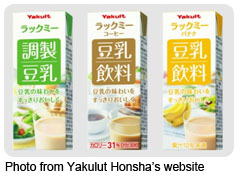 Yakult is mainly engaged in door-to-door sales and home delivering by so-called “Yakult Ladies”. With the major product of the company, “Yakult” at the base, they place soymilk and other beverages as additional products, but this August, the sales volume of soybean products rose 9%, and “Adjusted Soymilk,” food for specified health uses, jumped 19%. From October, they renewed the packages of “Luckme” series. In order to give the consumers an image of “deliciousness,” they printed a picture of soymilk poured inside a glass and has a catch copy of “refined, delicious soymilk flavor.”
Yakult is mainly engaged in door-to-door sales and home delivering by so-called “Yakult Ladies”. With the major product of the company, “Yakult” at the base, they place soymilk and other beverages as additional products, but this August, the sales volume of soybean products rose 9%, and “Adjusted Soymilk,” food for specified health uses, jumped 19%. From October, they renewed the packages of “Luckme” series. In order to give the consumers an image of “deliciousness,” they printed a picture of soymilk poured inside a glass and has a catch copy of “refined, delicious soymilk flavor.”- Nisshin Oilio group’s soybean products department is focusing more energy on creating functional products and proposals for new use in addition to soybean products using granulated soybean protein under the slogan of “power of soybeans.” One of the products is granulated soybean protein “New Comitex A-400 (10kg paper bag).” In addition to creating better texture of dumplings, shao-mai, and hamburger stakes, it could absorb drips of meat juice, and it is able to preserve the rich flavor. Also, a powered soybean product, “Alpha Plus HS-600 (20kg),” has been processed to take away the peculiar smell of soybeans. The texture is quite smooth and since it matches with other products, it could be used widely in beverages, breads, powder mixes, and healthy foods.
Products for Beauty and Anti-aging Have High Hopes for Their Future Growth
According to industry newspapers, the top selling products in pharmacies are collagen, glucosamine, turmeric, and vegetable juice. In grocery stores, lactic acid bacteria, plum extract, vegetable juice, and carrots are the top sellers. Consumers who limit their spending affect the prices of products, and the ones that are doing well are in the range of 1000 to 2000 yen. According to Yano Research Institute searching the market trend, multi vitamin for staying or becoming healthy sold 50 billion yen, vitamin C was 40 billion yen, vegetable juice was 44 billion yen, and chlorella was 20 billion yen. There are products for life style related diseases such as turmeric (30 billion yen), Asian ginseng (8.5 billion yen), Chitin and Chitosan (8.5 billion yen), and agaricus (7 billion yen). Collagen (55 billion yen) and coenzyme Q10 (10 billion yen) are the two products for beauty and anti-aging that are growing tremendously. Products targeting the middle age and higher are expanding, and we could count on future growth. Beauty, beautiful skin, and antioxidant are the keywords for the top selling products.
30% of the people are using both health foods and medical supplies
As seen in the consumer survey, products for beauty and anti-aging are popular. According to the “Survey for Health Foods” by Japan Housewives’ Association in March 2011, 40% of the people were currently using health foods, 20% have tried it before, and 60% have experienced taking healthy foods. The survey was conducted for 1,000 general consumers living in 15 prefectures from December 2010 to January 2011. 872 people answered the survey.
Asking the people who currently eat health foods (338 people) the types of healthy foods they eat, 110 people take 1 type (32.5%), 66 people take 2 types (19.5%), 27 people take 3 types (8.0%), and all together 1 to 3 types make up 60%.
Glucosamine and collagen topped as the types of health foods for ones who answered, “currently taking” or “have taken before”. Asking whether health foods and medical supplies are taken at the same time, 158 people (30.9%) answered that they “take both”. 75 people take “medicine that lowers the blood pressure” and 27 people take “medicine that lowers cholesterol”.
Asking the 511 people who have experienced eating health foods whether they look at the package, advertisements, or instructions other than getting explained by the shop clerk, 167 people (32.7%) answered that they “look very carefully”, 216 people (42.3%) answered that they “look”, 58 people (11.4%) answered that they “don’t look carefully”, and 17 people (3.3%) answered that they “don’t look”. Of all, 75% look at the package, advertisement, and instructions of the products for choosing.
Many consumers hope to get the heath food’s information such as its effects, principles, and scientific data. Also, they have strong interest in its safety and side effects when taken with drugs. This has become clear with the survey that was run by a working group of consumer study. Also, as a way to improve health conditions, taking heath foods ranked 3rd and there are high hopes for heath foods.
There was an online survey in November for 260 people (52 people for each category) who are 20-60 years old and eat heath foods more than once a week, totaling 520 people.
Table: Symptoms that bother people on a daily basis and symptoms that want to be improved by heath foods (multiple answers)
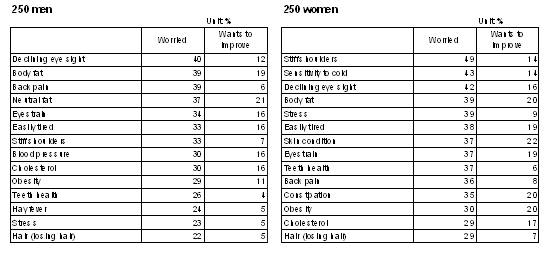 Sources: Shokuhin Sangyo Shimbun
Sources: Shokuhin Sangyo Shimbun
Figure: Improvements to become healthy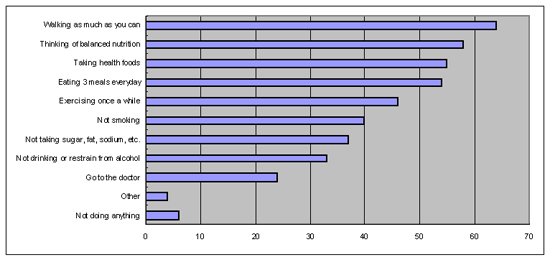 Sources: Shokuhin Sangyo Shimbun
Sources: Shokuhin Sangyo Shimbun
Introduction
Consumer’s awareness to health is rising. Well-known products such as citric acid, collagen, glucosamine and hyaluronic acid are popular.
Citric acid is used in dietary supplements and sports drink as it is said to help recover from fatigue and absorb calcium. Starting from China, it is imported from Austria, Columbia, United States, and Uruguay. China is one of the largest citric acid producing countries. Below are the data for imported citric acid and glucosamine.
Dietary supplements are divided into two. One is an overall supplement with vitamins and minerals, and the other is purpose & solution oriented supplement. For example, supplements that help maintain healthy eyes for people who are in front of the computer contain blueberries. Dietary supplements with brindleberry (Garcinia Cambodia) will help accelerate metabolism. To gain energy and stamina, there are products blended with arginine and cordyceps sinensis saccardo. There are healthy drinks to advance health that includes propolis and fucoidan.
Domestic multifunctional foods are as listed below
- Soybean multifunctional foods such as soybean bars and carbonated soybean drinks are attracting attention. “SOY JOY” from Otsuka group and “SOYSH” a carbonated soybean drink are new products containing all the functions of soybeans.
- A dairy lactobacillus drink, “Yakurt” sells over an average of 30 million per day (monthly) in the world. “Mil Mil” is a yogurt drink fermented for the first time in the world with lactobacillus bifidus particular to milk.
- AGF (Aginomonto General Foods) found out about coffee oligosaccharide, which have health functions that helps intestinal regulation, and produced “Blendy Stick Cafe Au Lait Morning Style.”
- Kaneka started selling “Reduced Form Coenzyme Q10” in 2010 and it is proved by animal testing to prevent Influenza A virus.
- Tujiseiyu’s main force is the beauty drink that includes moisturizing component called ceramide, along with collagen that gives flexibility to the skin, elastin peptide, vitamin C and B.
- Lonza Japan is selling “L-Carnitine”, which is good for improving neutral fat. It is included in many types of foods such as drinks, jelly, and supplements.
 Recently, mail orders are increasing as a way of selling the product. With mail orders, the success rate is high because it explains each of the products’ features carefully over and over again, allowing the “single article appeal” to stay fixed in the consumer’s minds. In single article appeal, it is important to show the individuality of the company and its functional items that are limited to that company. With functional items, one is something direct like supplements, and the other is something indirect like foods and drinks that include those items. In the health foods industry with many ambiguous points, “evidence” used to be the keyword. From now on, in addition to data and words, it is important that the consumers could “feel” the direct effect of the product.
Recently, mail orders are increasing as a way of selling the product. With mail orders, the success rate is high because it explains each of the products’ features carefully over and over again, allowing the “single article appeal” to stay fixed in the consumer’s minds. In single article appeal, it is important to show the individuality of the company and its functional items that are limited to that company. With functional items, one is something direct like supplements, and the other is something indirect like foods and drinks that include those items. In the health foods industry with many ambiguous points, “evidence” used to be the keyword. From now on, in addition to data and words, it is important that the consumers could “feel” the direct effect of the product.
Source: Fuji Keizai and other Japanese Media.

